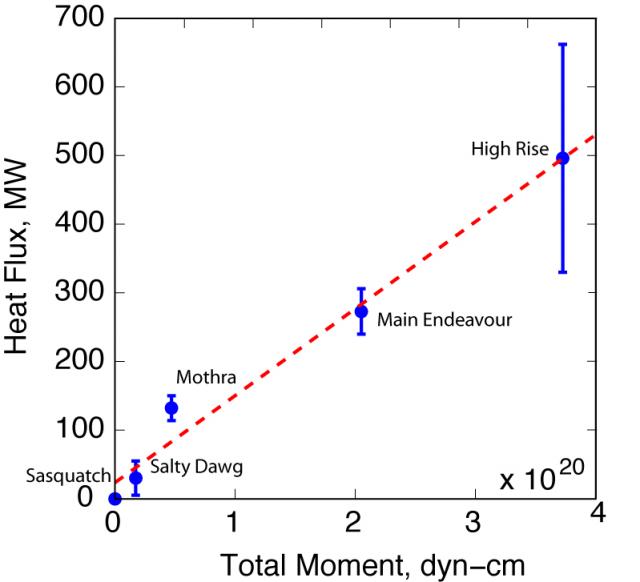Wilcock
My recent ridge-related fieldwork has been exclusively focused on the Endeavour Segment of the Juan de Fuca Ridge. Here we deployed a small high-quality seismic network from 2003-2006 to monitor microearthquakes. At the vent field scale, the results show a strong correlation between seismicity rates and hydrothermal heat fluxes measured by other researchers (see attached Figure) and document a seismicity pattern that is consistent with the expected signature of steady magma injection beneath the most hydrothermally vigorous fields [Wilcock et al., 2009]. At the segment scale, two swarms in January and February 2005 are consistent with non-eruptive magmatic extension on the southward extension of the West Valley propagator and the northern portion of the Endeavour Ridge, respectively [Hooft et al., 2010; Weekly et al., 2008]. Seismicity rates on the Endeavour dropped dramatically following these events, leading one of my students to conclude that the swarms marked the end of a 6-year spreading event that started in 1999 and ruptured the whole segment [Weekly et al., 2008]. One year ago we completed an ambitious tomography experiment that comprised ~5500 shots recorded at 64 OBS sites at 3 nested scales – those of the whole segment, the upper-crustal axial magma chamber (AMC) reflector and the vent fields. The analysis is still in the early stages but will provide new constraints on the distribution and nature of melt supply from the mantle to the crust, the magmatic structure of the lower crust and its linkages to the presence/absence of an AMC, and the structure of the thermal boundary layer and hydrothermally altered/fractured zone overlying the AMC. Amongst other objectives, the combination of tomographic and microearthquake data should provide a unique opportunity to better understand physical processes in the magmatic-hydrothermal interaction zone.
Integration and Synthesis (I&S)
I have a number of personal goals for this workshop. (1) I have had a long-standing interest in event plumes and I believe that recent observations in the Eastern Pacific provide an opportunity to refine and evaluate competing models for their formation. (2) Much of my research is currently focused on understanding the process by which hydrothermal systems uptake magmatic heat. Geophysical constraints require that the magmatic systems are separated from hydrothermal systems by a thin (~10-m-thick) conductive boundary layer while the geochemical observations constrain the characteristics of an overlying region where the fluids react with the rock. I think these two different perspectives focusing on the heat-uptake and reaction zones are not always very well reconciled and I think there is an opportunity for I&S. (3) I teach a class to seniors at the UW on Marine Geology and Geophysics which focuses on the creation, evolution and destruction of ocean basins and thus devotes significant time to oceanic spreading centers. Relative to their importance, I think mid-ocean ridges are grossly underrepresented in undergraduate geosciences education, perhaps because many ridge researchers have been located in research institutions or in university departments with limited undergraduate interaction. I am interested in ideas for how this might be rectified.
In the longer term, I think R2K needs to recognize that while the program might be ending, research on ridges should not and that our I&S efforts need to set the stage for new experiments. In the field of seismology, the R/V Marcus G. Langseth and the expanding capabilities of US National Ocean Bottom Seismography Instrument Pool are providing new capabilities to conduct 3-D MCS experiments and active source and passive source tomography experiments of unprecedented scope and resolution. At the Endeavour and Axial Seamount the development of cabled observatories provides a unique opportunity for long term seismic and hydrothermal monitoring that should be complemented by autonomous and mooring supported experiments elsewhere. While I have no expertise in the area of chemical and biological studies, I am pretty sure that new sensors and techniques are providing similarly exciting opportunities in these fields. These new opportunities are expensive and may require and approach whereby field experiments are increasingly justified and staged as coordinated community experiments (a trend that to some extent commenced with the Lau ISS and which is being discussed by the marine seismic community). Our community needs to figure out how to become a Big Science.
Hooft, E. E. E., W. S. D. Wilcock, H. Patel, D. R. Toomey, K. Becker, D. A. Butterfield, E. E. Davis, and M. D. Lilley (2010), A complex seismic swarm associated with local and regional hydrothermal and hydrological perturbations: the northern Endeavour segment February/March 2005, Geochem. Geophys. Geosyst., submitted.
Thompson, W. J., R. E. McDuff, F. R. Stahr, D. R. Yoerger, and M. Jakuba (2005), Heat flux from the Endeavour segment of the Juan de Fuca Ridge, Eos Trans. AGU, 86(52), Fall Meet. Suppl. Abstract T31A-0489.
Weekly, R. T., W. S. Wilcock, D. R. Toomey, E. E. Hooft, and P. R. McGill (2008), An automatically generated earthquake catalog for the Endeavour Segment of the Juan de Fuca ridge: Linkages between segment and vent-field scale seismicity, Eos Trans. AGU, 89(53), Fall Meet. Suppl. Abstract V54B-02.
Wilcock, W. S. D., E. E. E. Hooft, D. R. Toomey, P. R. McGill, A. H. Barclay, D. S. Stakes, and T. M. Ramirez (2009), The role of magma injection in localizing black smoker activity, Nature Geosci., 2, 509-513.
Figure. Plot of the seismic moment release beneath each Endeavour vent field for summer 2003 – summer 2004 versus the heat flux measured in summer 2004 [Thompson et al., 2005].

